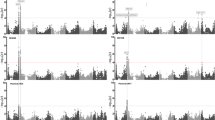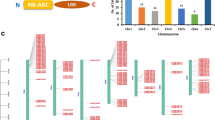Abstract
Aphids such as the bird cherry-oat aphid (Rhopalosiphum padi L.) are serious pests in agriculture worldwide. Partially resistant barley genotypes have been produced in a breeding program for resistance to R. padi. The resistance is manifested as smaller aphids after a certain period of nymphal growth on the test plants. A large number of doubled haploid breeding lines thereby characterized as partially resistant or susceptible to R. padi are available from this breeding program. In the present study a selection of these lines, spanning four generations and 23 genotypes, was used for the evaluation of the constitutive transcript abundance of gene sequences in young barley plants. The genes were selected from an earlier microarray study where they had been identified as being up-regulated by aphids in all four barley genotypes studied or differentially up-regulated or constitutively expressed in the two resistant as compared to the two susceptible barley genotypes. The prediction for constitutive transcript abundance across the selection of genotypes was here confirmed for five out of eight investigated genes. Two of these were, as predicted, expressed at equal levels in all genotypes. Two gene sequences exhibited higher transcript abundance in resistant than in susceptible offspring; one coding for a thionin and another for a proteinase inhibitor. A lipoxygenase gene had higher transcript abundance in the susceptible lines. The study thus gives further support for putative constitutive roles of three genes previously identified as significant in the barley–R. padi interaction.


Similar content being viewed by others
References
Afzal AJ, Wood AJ, Lightfoot DA (2008) Plant receptor-like serine threonine kinases: roles in signaling and plant defense. Mol Plant Microbe Interact 21:507–517
Åhman I, Tuvesson S, Johansson M (2000) Does indole alkaloid gramine confer resistance in barley to aphid Rhopalosiphum padi? J Chem Ecol 26:233–255
Atamian HS, Chaudhary R, Dal Cin V, Bao E, Girke T, Kaloshian I (2013) In planta expression or delivery of potato aphid Macrosiphum euphorbiae effectors Me10 and Me23 enhances aphid fecundity. Mol Plant Microbe Interact 26:67–74
Avila CA, Arévalo-Soliz LM, Jia LL, Navarre DA, Chen Z, Howe GA, Meng QW, Smith JE, Goggin FL (2012) Loss of function of FATTY ACID DESATURASE7 in tomato enhances basal aphid resistance in a salicylate-dependent manner. Plant Physiol 158:2028–2041
Avila CA, Arevalo-Soliz LM, Lorence A, Goggin FL (2013) Expression of alpha- DIOXYGENASE 1 in tomato and Arabidopsis contributes to plant defenses against aphids. Mol Plant Microbe Interact 26:977–986
Besser K, Jarosch B, Langen G, Kogel KH (2000) Expression analysis of genes induced in barley after chemical activation reveals distinct disease resistance pathways. Mol Plant Pathol 1:277–286
Blackman RL, Eastop VF (1984) Aphids on the world′s crops: An identification guide. Wiley, Chicester
Bohlmann H, Apel K (1991) Thionins. Annu Rev Plant Physiol Plant Mol Biol 42:227–240
Bos JIB, Prince D, Pitino M, Maffei ME, Win J, Hogenhout SA (2010) A functional genomics approach identifies candidate effectors from the aphid species Myzus persicae (green peach aphid). PLoS Genet 6:e1001216
Botha A-M, Lacock L, van Niekerk C, Matsioloko MT, du Preez FB, Loots S, Venter E, Kunert KJ, Cullis CA (2006) Is photosynthetic transcriptional regulation in Triticum aestivum L. cv. ‘TugelaDN’ a contributing factor for tolerance to Diuraphis noxia (Homoptera: Aphididae)? Plant Cell Rep 25:41–54
Broekgaarden C, Poelman EH, Steenhuis G, Voorrips RE, Dicke M, Vosman B (2008) Responses of Brassica oleracea cultivars to infestation by the aphid Brevicoryne brassicae: an ecological and molecular approach. Plant Cell Environ 31:1592–1605
Bunge S, Wolters J, Apel K (1992) A comparison of leaf thionin sequences of barley cultivars and wild barley species. Mol Gen Genet 231:460–468
Carrillo L, Martinez M, Álvarez-Alfageme F, Castañera P, Smagghe G, Diaz I, Ortego F (2011) A barley cysteine-proteinase inhibitor reduces the performance of two aphid species in artificial diets and transgenic Arabidopsis plants. Transgenic Res 20:305–319
Casaretto JA, Corcuera LJ (1998) Proteinase inhibitor accumulation in aphid-infested barley leaves. Phytochemistry 49:2279–2286
Charity JA, Hughes P, Anderson MA, Bittisnich DJ, Whitecross M, Higgins TJV (2005) Pest and disease protection conferred by expression of barley beta-hordothionin and Nicotiana alata proteinase inhibitor genes in transgenic tobacco. Funct Plant Biol 32:35–44
De Vos M, Kim JH, Jander G (2007) Biochemistry and molecular biology of Arabidopsis-aphid interactions. Bioessays 29:871–883
Delp G, Gradin T, Åhman I, Jonsson LMV (2009) Microarray analysis of the interaction between the aphid Rhopalosiphum padi and host plants reveals both differences and similarities between susceptible and partially resistant barley lines. Mol Genet Genomics 281:233–248
Dogimont C, Bendahmane A, Chovelon V, Boissot N (2010) Host plant resistance to aphids in cultivated crops: genetic and molecular bases, and interactions with aphid populations. CR Biol 333:566–573
Florack DEA, Stiekema WJ (1994) Thionins: properties, possible biological roles and mechanisms of action. Plant Mol Biol 26:25–37
Gao L-L, Kamphuis LG, Kakar K, Edwards OR, Udvardi MK, Singh KB (2010) Identification of potential early regulators of aphid resistance in Medicago truncatula via transcription factor expression profiling. New Phytol 186:980–994
Glinwood R, Gradin T, Karpinska B, Ahmed E, Jonsson L, Ninkovic V (2007) Aphid acceptance of barley exposed to volatile phytochemicals differs between plants exposed in daylight and darkness. Plant Signal Behav 2:321–326
Goggin FL (2007) Plant-aphid interactions: molecular and ecological perspectives. Curr Opin Plant Biol 10:399–408
Hamada AM, Jonsson LMV (2013) Thiamine treatments alleviate aphid infestations in barley and pea. Phytochemistry 94:135–141
Hause B, Vörös K, Kogel K-H, Besser K, Wasternack C (1999) A jasmonate-responsive lipoxygenase of barley leaves is induced by plant activators but not by pathogens. J Plant Physiol 154:459–462
Holtorf S, Apel K, Bohlmann H (1995) Specific and different expression patterns of two members of the leaf thionin multigene family of barley in transgenic tobacco. Plant Sci 111:27–37
Hoshikawa K, Ishihara G, Takahashi H, Nakamura I (2012) Enhanced resistance to gray mold (Botrytis cinerea) in transgenic potato plants expressing thionin genes isolated from Brassicaceae species. Plant Biotechnol 29:87–93
Jones JDG, Dangl JL (2006) The plant immune system. Nature 444:323–329
Kaloshian I (2004) Gene-for-gene disease resistance: bridging insect pest and pathogen defense. J Chem Ecol 30:2419–2438
Kaloshian I, Walling LL (2005) Hemipterans as plant pathogens. Annu Rev Phytopathol 43:491–521
Kieckhefer RW, Gellner JL, Riedell WE (1995) Evaluation of the aphid-day standard as a predictor of yield loss caused by cereal aphids. Agron J 87:785–788
Kogel K-H, Ortel B, Jarosch B, Atzorn R, Schiffer R, Wasternack C (1995) Resistance in barley against the powdery mildew fungus (Erysiphe graminis f.sp.hordei) is not associated with enhanced levels of endogenous jasmonates. Eur J Plant Pathol 101:319–332
Larsen ET, Tuvesson IKD, Andersen SB (1991) Nuclear genes affecting percentage of green plants in barley (Hordeum vulgare L.) anther culture. Theor Appl Genet 82:417–420
Larsson KAE, Zetterlund I, Delp G, Jonsson LMV (2006) N-methyltransferase involved in gramine biosynthesis in barley: cloning and characterization. Phytochemistry 67:2002–2008
Larsson KAE, Saheed SA, Gradin T, Delp G, Karpinska B, Botha CEJ, Jonsson LMV (2011) Differential regulation of 3-aminomethylindole/N-methyl-3-aminomethylindole N-methyltransferase and gramine in barley by both biotic and abiotic stress conditions. Plant Physiol Bioch 49:96–102
Leather SR, Walters KFA, Dixon AFG (1989) Factors determining the pest status of the bird cherry-oat aphid, Rhopalosiphum padi (L.) (Hemiptera: Aphididae), in Europe: a study and review. Bull Entomol Res 79:345–360
Louis J, Lorenc-Kukula K, Singh V, Reese J, Jander G, Shah J (2010) Antibiosis against the green peach aphid requires the Arabidopsis thaliana MYZUS PERSICAE-INDUCED LIPASE1 gene. Plant J 64:800–811
Mangelsen E, Wanke D, Kilian J, Sundberg E, Harter K, Jansson C (2010) Significance of light, sugar, and amino acid supply for diurnal gene regulation in developing barley caryopses. Plant Physiol 153:14–33
Morkunas I, Mai VC, Gabry′s B (2011) Phytohormonal signaling in plant responses to aphid feeding. Acta Physiol Plant 33:2057–2073
Muramoto N, Tanaka T, Shimamura T, Mitsukawa N, Hori E, Koda K, Otani M, Hirai M, Nakamura K, Imaeda T (2012) Transgenic sweet potato expressing thionin from barley gives resistance to black rot disease caused by Ceratocystis fimbriata in leaves and storage roots. Plant Cell Rep 31:987–997
Ninkovic V, Åhman I (2009) Aphid acceptance of Hordeum genotypes is affected by plant volatile exposure and is correlated with aphid growth. Euphytica 169:177–185
Park SJ, Huang YH, Ayoubi P (2006) Identification of expression profiles of sorghum genes in response to greenbug phloem-feeding using cDNA subtraction and microarray analysis. Planta 223:932–947
Pauquet J, Burget E, Hagen L, Chovelon V (2004) A LM, Valot N, Desloire S, Caboche M, Rousselle P, Pitrat M, Bendahmane A, Dogimont C (2004) Map-based cloning of the Vat gene from melon conferring resistance to both aphid colonization and aphid transmission of several viruses. In: Lebeda A, Paris H (eds) Cucurbitaceae 2004, the 8th EUCARPIA meeting on Cucurbit genetics and breeding. Palacky University, Olomouc, pp 325–329
Pyati P, Bandani AR, Fitches E, Gatehouse JA (2011) Protein digestion in cereal aphids (Sitobion avenae) as a target for plant defence by endogenous proteinase inhibitors. J Insect Physiol 57:881–891
Rahbé Y, Deraison C, Bonadé-Bottino M, Girard C, Nardon C, Jouanin L (2003) Effects of the cysteine protease inhibitor oryzacystatin (OC-I) on different aphids and reduced performance of Myzus persicae on OC-I expressing transgenic oilseed rape. Plant Sci 164:441–450
Reddy SK, Weng YQ, Rudd JC, Akhunova A, Liu SY (2013) Transcriptomics of induced defense responses to greenbug aphid feeding in near isogenic wheat lines. Plant Sci 212:26–36
Reimann-Philipp U, Schrader G, Martinoia E, Barkholt V, Apel K (1989) Intracellular thionins of barley. J Biol Chem 264:8964–8978
Singh V, Louis J, Ayre BG, Reese JC, Pegadaraju V, Shah J (2011) TREHALOSE PHOSPHATE SYNTHASE11-dependent trehalose metabolism promotes Arabidopsis thaliana defense against the phloem-feeding insect Myzus persicae. Plant J 67:94–104
Smith CM, Boyko EV (2007) The molecular bases of plant resistance and defense responses to aphid feeding: current status. Entomol Exp Appl 122:1–16
Soong R, Beyser K, Basten O, Kalbe A, Rueschoff J, Tabiti K (2001) Quantitative reverse transcription-polymerase chain reaction detection of cytokeratin 20 in noncolorectal lymph nodes. Clin Cancer Res 7:3423–3429
Studham ME, MacIntosh GC (2013) Multiple phytohormone signals control the transcriptional response to soybean aphid infestation in susceptible and resistant soybean plants. Mol Plant Microbe Interact 26:116–129
Thompson GA, Goggin FL (2006) Transcriptomics and functional genomics of plant defence induction by phloem-feeding insects. J Exp Bot 57:755–766
Tran P, Cheesbrough TM, Keickhefer RW (1997) Plant proteinase inhibitors are potential anticereal aphid compounds. J Econ Entomol 90:1672–1677
Walling LL (2008) Avoiding effective defenses: strategies employed by phloem-feeding insects. Plant Physiol 146:859–866
Wei F, Wing RA, Wise RP (2002) Genome dynamics and evolution of the Mla (powdery mildew) resistance locus in barley. Plant Cell 14:1903–1917
Wroblewski T, Piskurewicz U, Tomczak A, Ochoa O, Michelmore RW (2007) Silencing of the major family of NBS–LRR-encoding genes in lettuce results in the loss of multiple resistance specificities. Plant J 51:803–818
Acknowledgments
The authors wish to thank Lantmännen Lantbruk for providing plant material and Mistra for funding via the PlantComMistra program. The funding agency had no involvement in the study.
Author information
Authors and Affiliations
Corresponding author
Electronic supplementary material
Below is the link to the electronic supplementary material.
Rights and permissions
About this article
Cite this article
Mehrabi, S., Åhman, I. & Jonsson, L.M.V. Transcript abundance of resistance- and susceptibility-related genes in a barley breeding pedigree with partial resistance to the bird cherry-oat aphid (Rhopalosiphum padi L.). Euphytica 198, 211–222 (2014). https://doi.org/10.1007/s10681-014-1093-5
Received:
Accepted:
Published:
Issue Date:
DOI: https://doi.org/10.1007/s10681-014-1093-5




